A powerhouse 260 mph jet stream sent KLM Flight 644’s ground speed over Newfoundland in the Canadian Maritimes Friday night to an astounding 819 mph.
Meanwhile, the same jet stream, which fuels Storm Ciara currently pounding the UK, helped a plane to beat the transatlantic flight record (New York to London) in 4 hours and 56 minutes.

The Boeing 747-436 reached speeds of 825 mph (1,327 km/h) as it rode the phenomenal 260 mph jet stream fueling Storm Ciara.
It arrived 80 minutes ahead of schedule at Heathrow Airport in London on Sunday morning.
The powerful jet stream helped the plane beat the transatlantic flight record in 4 hours and 56 minutes.
Thanks to a strong, well-positioned jet stream, a @British_Airways 747 managed a new New York-London subsonic speed record today, making the journey in 4 hours 56 minutes—17 minutes faster than the previous record. https://t.co/HISXpN6Vns #BA112 pic.twitter.com/A2R42rsx14
— Flightradar24 (@flightradar24) February 9, 2020
The previous record for a 747 was 5 hour 13 minute, while the average travel time from JFK to Heathrow is 6 hours 13 minutes.
Such flight speed are phenomenal! Last year, also in February, another high jet stream speed of more than 231 mph also made the headlines.
Almost 800 mph now never ever seen this kind of tailwind in my life as a commercial pilot !! (200 mph tailwind ) pic.twitter.com/0XGTkEP9EB
— Peter James (@jetpeter1) February 19, 2019
Last year also, satellites recorded the strongest summer Jet Stream ever over the Pacific Northwest.
Jet stream speeds
The jet stream is a river of fast moving air at 30,000 – 35,000 feet a.s.l.. It sheers storms, and can have a huge impact on the duration of a flight.
The jet stream typically reaches its highest speeds during the wintertime, with maximum velocities of around 160 knots (184 mph). So the current jet stream speed is indeed monstrous (about 80 mph above average!).
The strong jet stream crossing the North Atlantic is leading to astounding airliner ground speeds > 800 mph
— Ryan Maue (@RyanMaue) February 9, 2020
Climate scientists have directly linked these jet stream wind increases to climate change.
So thank global warming when you land 2-hours early! pic.twitter.com/21XJz3Em2G
The jet stream can reach such speeds because the air is much thinner at those heights, and there is virtually no friction impeding the flow.
This is also why the majority of commercial jets fly at those altitudes and the transatlantic flight record is sometimes beaten. More extreme weather news on Strange Sounds or Steve Quayle. [Facebook]












